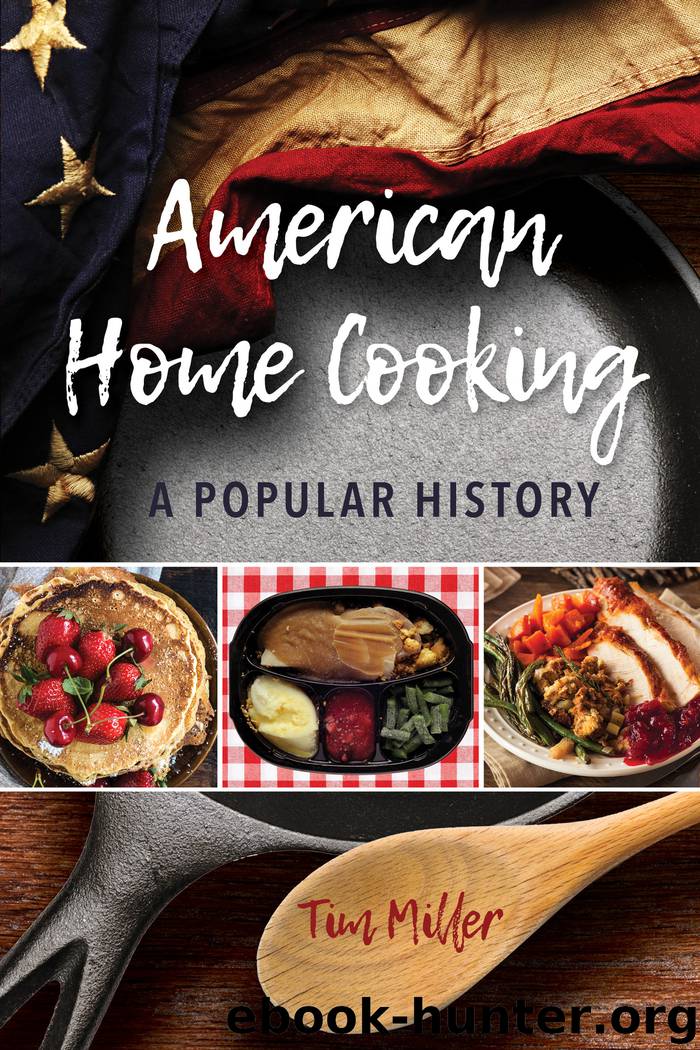American Home Cooking by Tim Miller

Author:Tim Miller
Language: eng
Format: epub
Tags: undefined
Publisher: Rowman & Littlefield Publishers
Published: 2012-12-20T05:00:00+00:00
Between the end of the Civil War in 1865 and the end of World War II in 1945, many trends affected Americans’ relationship with home cooking. Three events that changed both America and the world also had some effects on food and cooking in America.
Of the three events, World War I was the shortest. The United States formally entered the war in 1917, years after its beginning in Europe; sent no soldiers to Europe before the spring of 1918; and was only involved in a few battles before the end of the war in November 1918. Because the American government assumed the war would continue for years after our entry, some drastic measures were instituted, including food rationing, but, overall, the war did not have too great an effect on cooking.
The second event lasted the longest, as the Great Depression swallowed up most of the 1930s. The economy was in a shambles through most of the period—in 1933, the worst year of the Depression, a quarter of available workers were unemployed, and the unemployment rate would stay above 10 percent for the rest of the decade. The Depression’s main impact on cooking was economic in that most Americans did not have enough money to visit restaurants regularly or to buy much processed food. Home cooking enabled families to stretch their money through substitutions in recipes, adding, for example, oatmeal to hamburger to extend the meat a little further. The Depression also had an impact on gender roles and relations. The types of jobs women typically performed, like nurse, teacher, secretary, or sales clerk, turned out to be the jobs that were still needed during an economic downturn, unlike male-oriented jobs such as factory worker or general laborer. Thus, by the end of the 1930s more women were working than at the beginning of the decade, and quite frequently their spouses were either unemployed or working only a few hours a week. In that situation, some men took up some of the slack in the kitchen.
And then there was World War II. Long-term rationing, which included food, influenced home cooking by spurring those with outdoor space to keep gardens. However, with millions of men at war and millions of women working outside the home, there was a greater need for both convenience foods and food prepared outside the home. Sales of cake mixes flourished partially because, at a time when both sugar and shortening were rationed, cake mixes were not, and also because cake mixes could be prepared quickly.[58] Restaurant usage surged for largely the same reasons: more money in workers’ pockets, less time for those workers (large numbers of which were women), and the fact that restaurants meals were not rationed.
Although Americans did not realize it at the time, the end of World War II, in 1945, signaled the beginning of an economic boom that would carry well into the 1960s, lifting millions of Americans from the working class into the middle class. They had disposable income and frequently chose to spend that income on convenience foods, trading the time they gained for the money they spent.
Download
This site does not store any files on its server. We only index and link to content provided by other sites. Please contact the content providers to delete copyright contents if any and email us, we'll remove relevant links or contents immediately.
| Anthropology | Archaeology |
| Philosophy | Politics & Government |
| Social Sciences | Sociology |
| Women's Studies |
The Leavers by Lisa Ko(6459)
Born to Run: by Christopher McDougall(6249)
iGen by Jean M. Twenge(4693)
Sapiens by Yuval Noah Harari(4528)
The Kite Runner by Khaled Hosseini(4413)
Spare by Prince Harry The Duke of Sussex(4188)
Bullshit Jobs by David Graeber(3171)
Livewired by David Eagleman(3113)
Goodbye Paradise(2948)
Never by Ken Follett(2869)
A Dictionary of Sociology by Unknown(2516)
Harry Potter 4 - Harry Potter and The Goblet of Fire by J.K.Rowling(2413)
The Club by A.L. Brooks(2350)
People of the Earth: An Introduction to World Prehistory by Dr. Brian Fagan & Nadia Durrani(2345)
The Social Psychology of Inequality by Unknown(2304)
Machine Learning at Scale with H2O by Gregory Keys | David Whiting(2263)
Harry Potter and the Order of the Phoenix (5) by J.K. Rowling(2224)
0041152001443424520 .pdf by Unknown(2213)
Don't Sleep, There Are Snakes by Daniel L. Everett(2212)
